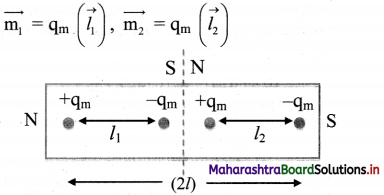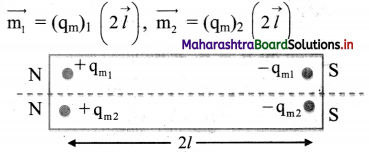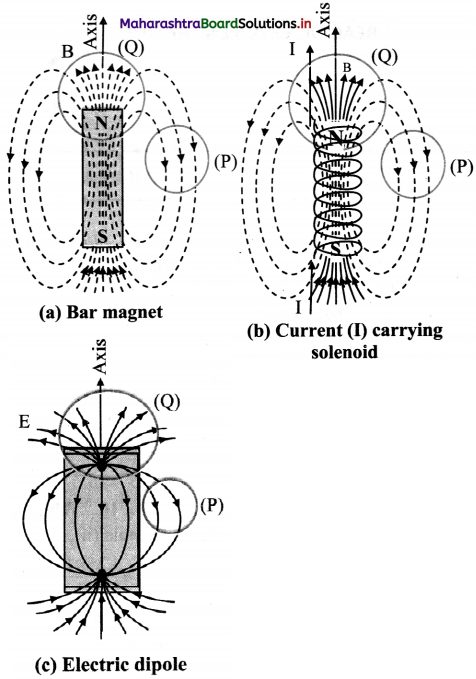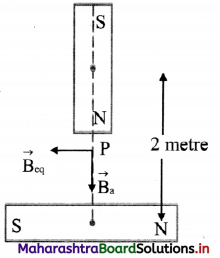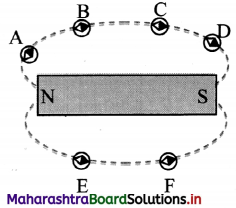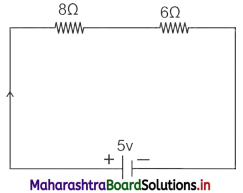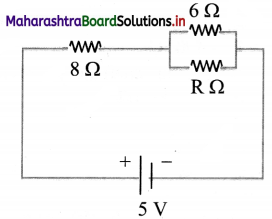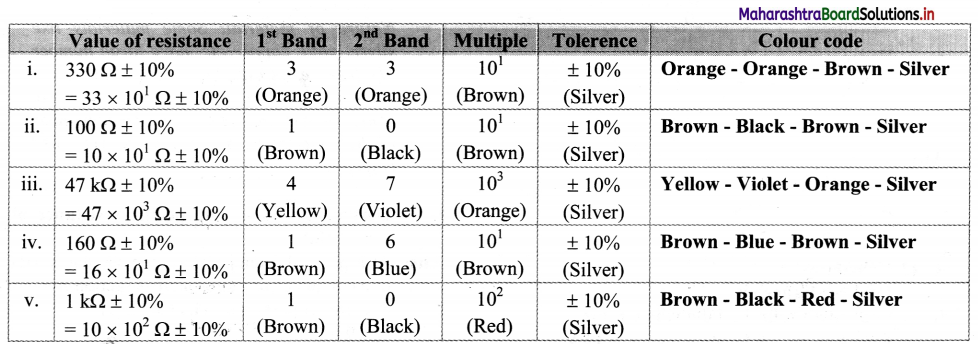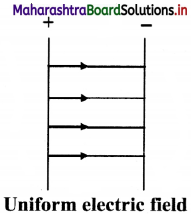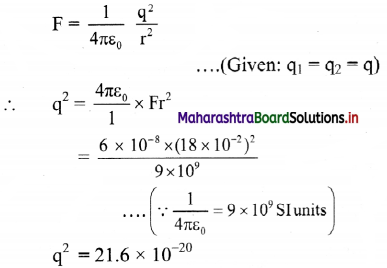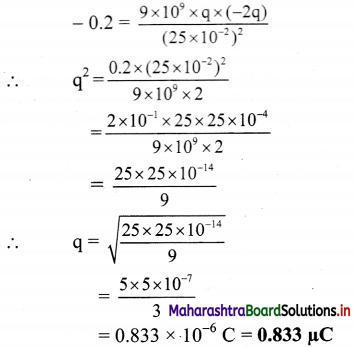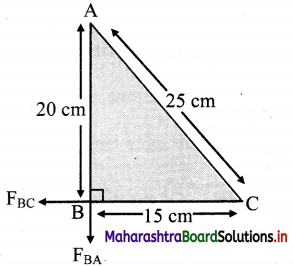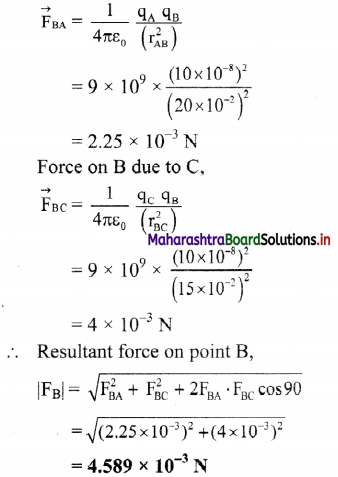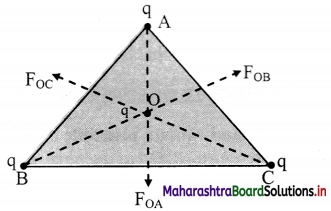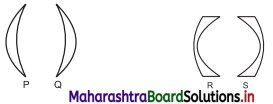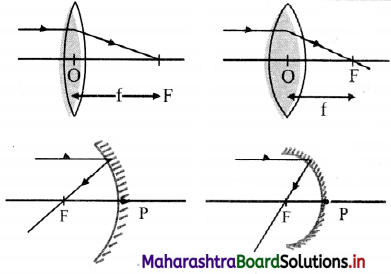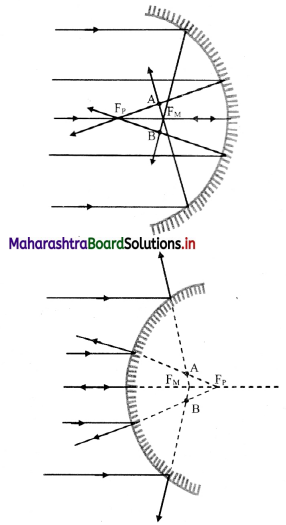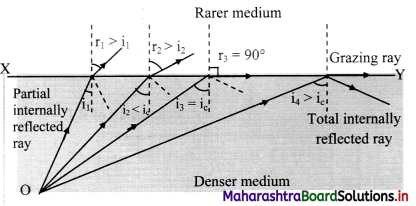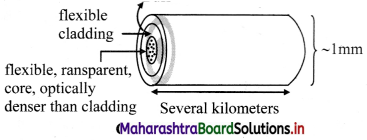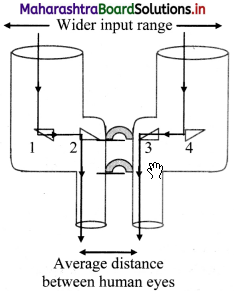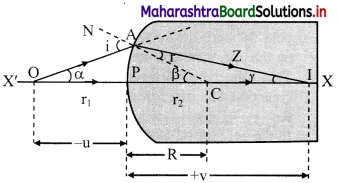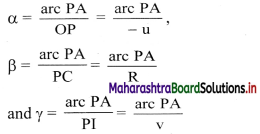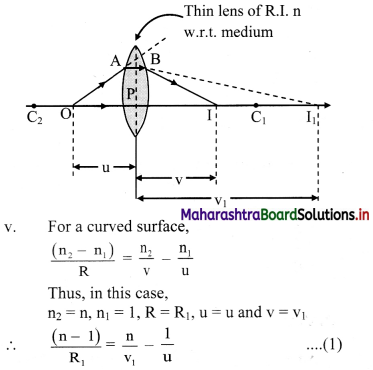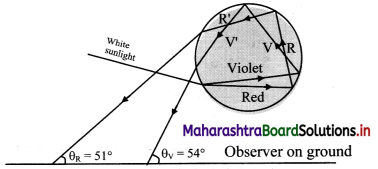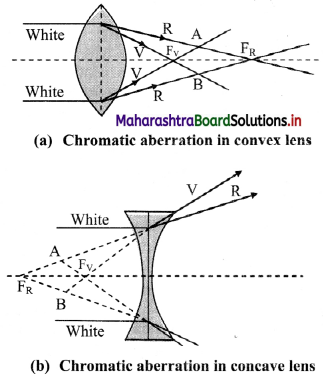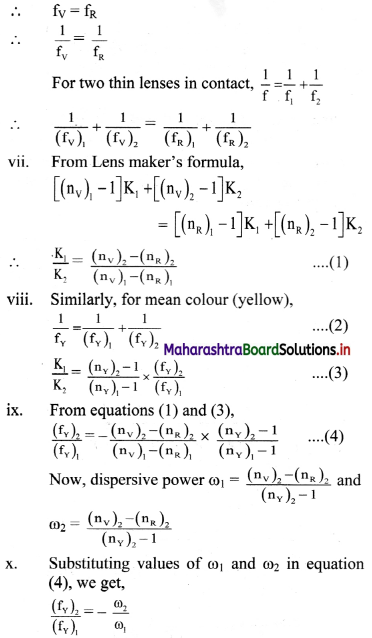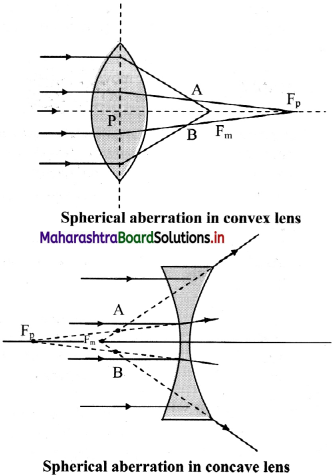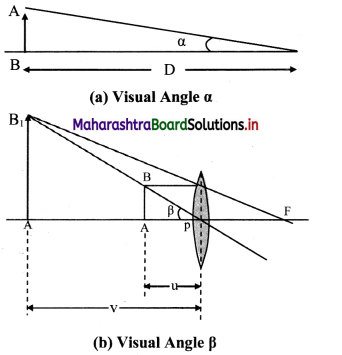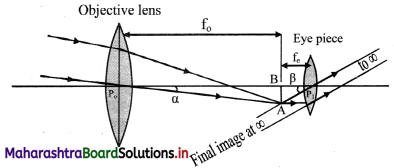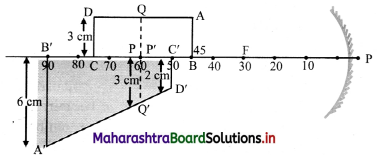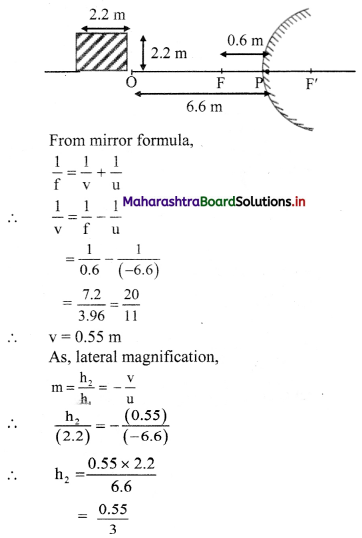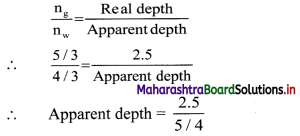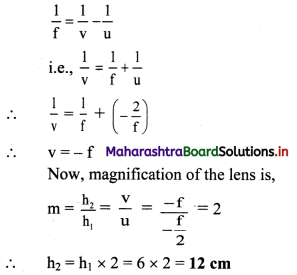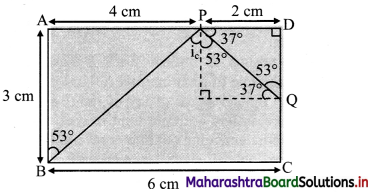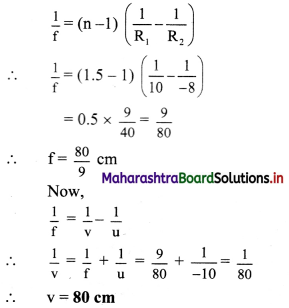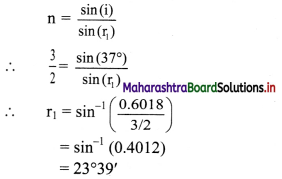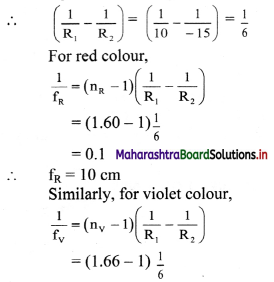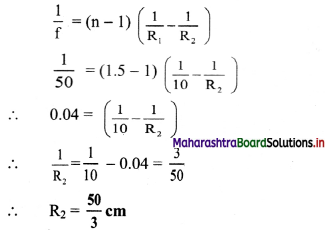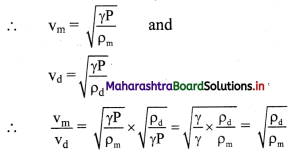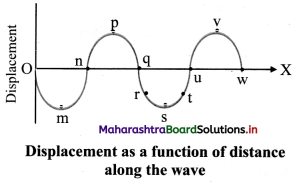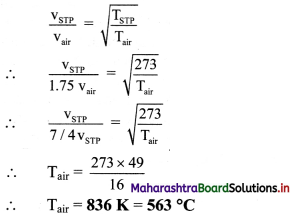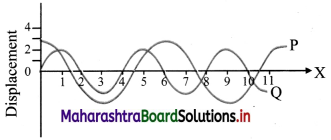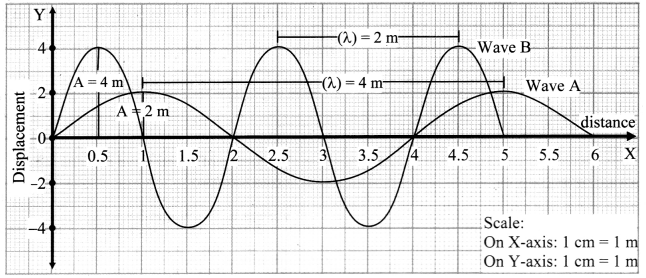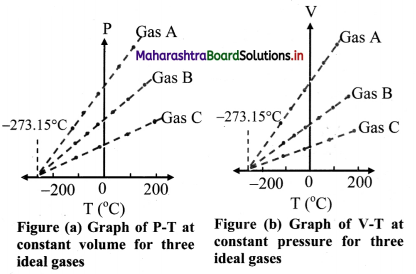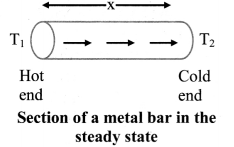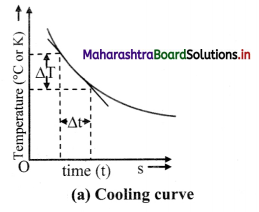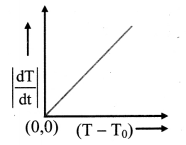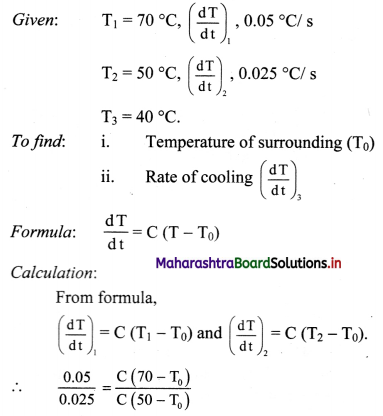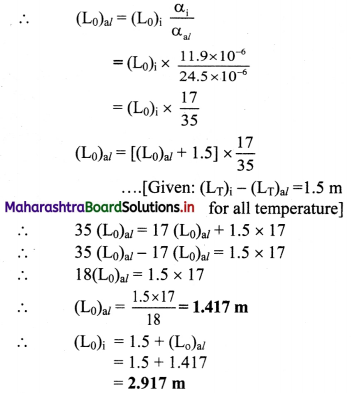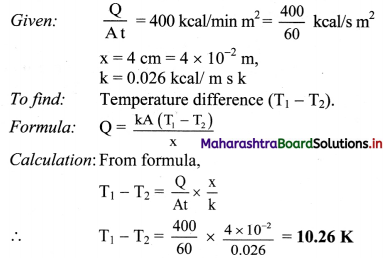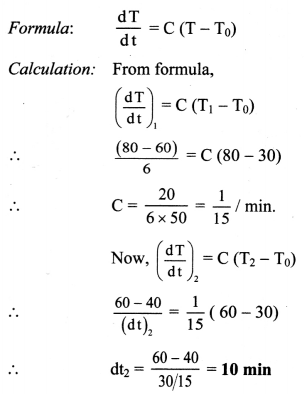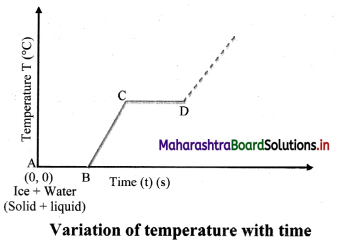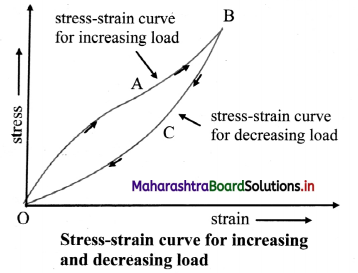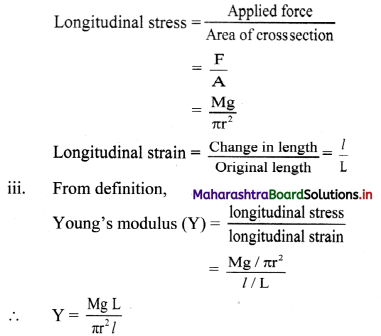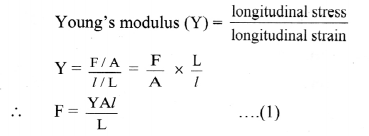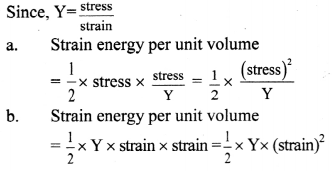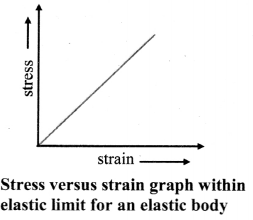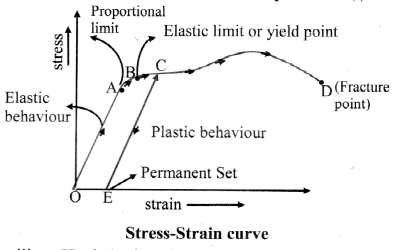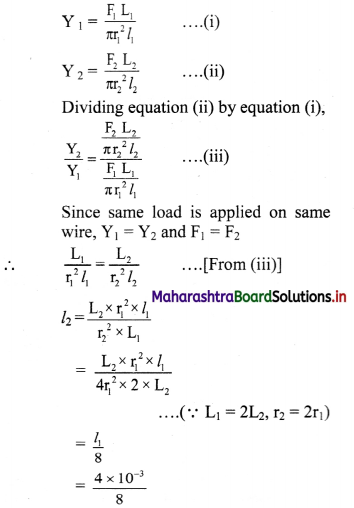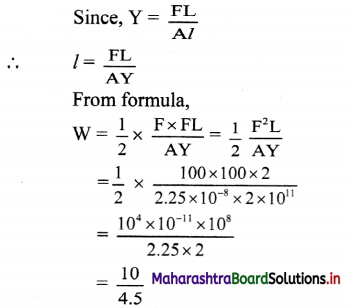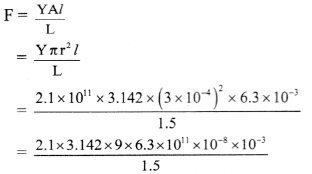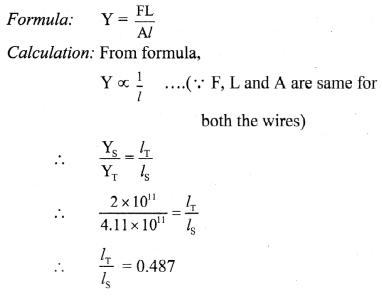Cell Division Class 11 Exercise Question Answers Solutions Maharashtra Board
Balbharti Maharashtra State Board 11th Biology Textbook Solutions Chapter 7 Cell Division Textbook Exercise Questions and Answers.
Class 11 Biology Chapter 7 Exercise Solutions Maharashtra Board
Biology Class 11 Chapter 7 Exercise Solutions
1. Choose the correct option
Question (A)
The connecting link between Meiosis – I and Meiosis – II is …………
(a) interphase – I
(b) interphase – II
(c) interkinesis – III
(d) anaphase – IV
Answer:
(c) interkinesis – III
![]()
Question (B)
Synapsis is pairing of ………………. .
(a) any two chromosomes
(b) non – homologous chromosomes
(c) sister chromatids
(d) homologous chromosomes
Answer:
(d) homologous chromosomes
Question (C)
Spindle apparatus is formed during which stage of mitosis?
(a) Prophase
(b) Metaphase
(c) Anaphase
(d) Telophase
Answer:
(b) S-phase
Question (D)
Chromosome number of a cell is almost doubled up during _______ .
(a) G1 – phase
(b) S – phase
(c) G2-phase
(d) G0-phase
[Note: Due to DNA replication the DNA content of cell doubles during S-phase. But the number of chromosomes remain the same.]
Answer:
(b) S – phase
![]()
Question (E)
How many meiotic divisions are necessary for formation of 80 sperms?
(a) 80
(b) 40
(c) 20
(d) 10
Answer:
(c) 20
Question (F)
How many chromatids are present in anaphase – I of meiosis – I of a diploid cell having 20 chromosomes?
(a) 4
(b) 6
(c) 20
(d) 40
Answer:
(d) 40
Question (G)
In which of the following phase of mitosis chromosomes are arranged at equatorial plane?
(a) Prophase
(b) Metaphase
(c) Anaphase
(d) Telophase
Answer:
(b) Metaphase
Question (H)
Find incorrect statement.
(a) Condensation of chromatin material occurs in prophase.
(b) Daughter chromatids are formed in anaphase.
(c) Daughter nuclei are formed at metaphase.
(d) Nuclear membrane reappears in telophase.
Answer:
(c) Daughter nuclei are formed at metaphase.
Question (I)
Histone proteins are synthesized during
(a) G1 phase
(b) S – phase
(c) G2 – phase
(d) Interphase
Answer:
(b) S – phase
2. Answer the following questions
Question (A)
While observing a slide, student observed many cells with nuclei. But some of the nuclei were bigger as compared to others but their nuclear membrane was not so clear. Teacher inferred it as one of the phase in the cell division. Which phase may be inferred by teacher?
Answer:
Prophase.
![]()
Question (B)
Students prepared a slide of onion root tip. There were many cells seen under microscope. There was a cell seen under microscope. There was a cell with two groups of chromosomes at opposite ends of the cell. This cell is in which phase of mitosis?
Answer:
Anaphase.
Question (C)
Students were shown some slides of cancerous cells. Teacher made a comment as if there would have been a control at one of its cell cycle phase, there wouldn’t have been a condition like this. Which phase the teacher was referring to?
Answer:
The phase teacher was referring would be Gi phase.
Question (D)
Some Mendelian crossing experimental results were shown to the students. Teacher informed that there are two genes located on the same chromosome. He enquired if they will be ever separated from each other?
Answer:
- Genes are located on chromosomes at specific distance and position.
- The greater this distance, the greater the chance that a crossover can occur between the genes and the greater the chances of recombination.
- The chances of recombination are less between the genes that are placed closed to each other on the chromosome.
- Therefore, due to recombination the two genes located on the same chromosome have possibility of separating from each other.
Question (E)
Students were observing a film on Paramoecium. It underwent a process of reproduction. Teacher said it is due to cell division. But students objected and said that there was no disappearance of nuclear membrane and no spindle formation, how can it be cell division? Can you clarify?
Answer:
- Paramoecium is a unicellular organism. The division in Paramoecium occurs by amitosis.
- It is the simplest mode of cell division.
- In amitosis, nucleus elongates and a constriction appears. This constriction deepens and divides the nucleus in two daughter nuclei followed by the division of cytoplasm.
Question (F)
Is the meiosis responsible for evolution? Justify your answer.
Answer:
- Meiosis ensures that organisms produced by sexual reproduction contain correct number of chromosomes.
- Meiosis exhibits genetic variation by the process of recombination.
- Variations increase further after union of gametes during fertilization creating offspring with unique characteristics. Thus, it creates diversity of life and is responsible for evolution.
![]()
Question (G)
Why mitosis and meiosis – II are called as homotypic division?
Answer:
1. In mitosis, the chromosome number and genetic material of daughter cells remain same as that of the parent cell.
2. In meiosis – II, two haploid cells formed during first meiotic division divide further into four haploid cells. This division is identical to mitosis. The daughter cells formed in second meiotic division are similar to their parent cells with respect to the chromosome number formed in meiosis -1. Hence mitosis and meiosis – II are called homotypic division.
Question (H)
Write the significance of mitosis.
Answer:
- As mitosis is equational division, the chromosome number is maintained constant.
- It ensures equal distribution of the nuclear and the cytoplasmic content between the daughter cells, both quantitatively and qualitatively. Therefore, the process of mitosis also maintains the nucleo-cytoplasmic ratio.
- The DNA is also equally distributed.
- It helps in growth and development of organisms.
- Old and worn-out cells are replaced through mitosis.
- It helps in the asexual reproduction of organisms and vegetative propagation in plants.
Question (I)
Enlist the different stages of prophase – I.
Answer:
1. Prophase -I:
It is the most complicated and longest phase of meiotic division.
It is further divided into five sub-phases viz. leptotene, zygotene, pachytene, diplotene and diakinesis.
a. Leptotene:
The volume of the nucleus increases.
The chromosomes become long distinct and coiled.
They orient themselves in a specific fonn known as bouquet stage. This is characterized with the ends of chromosomes converged towards the side of nucleus where the centrosome lies. j Lep
The centriole duplicates into two and migrates to opposite poles. [Note: Centrioles divide during Gj phase of interphase.]
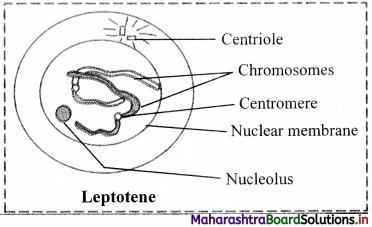
b. Zygotene:
Pairing of non-sister chromatids of homologous chromosomes takes place by formation of synaptonemal complex. This pairing is called synapsis.
Each pair consists of a maternal chromosome and a paternal chromosome. Chromosomal pairs are called bivalents or tetrads.
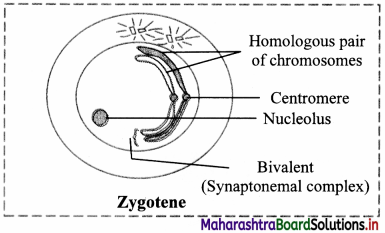
c. Pachytene:
Each individual chromosome begins to split longitudinally into two similar chromatids. Therefore, each bivalent now appears as a tetrad consisting of four chromatids.
The homologous chromosomes begin to separate but they do not separate completely and remain attached to one or more points. These points are called chiasmata (Appear like a cross-X).
Chromatids break at these points and broken segments are exchanged between non-sister chromatids of homologous chromosomes resulting in recombination.
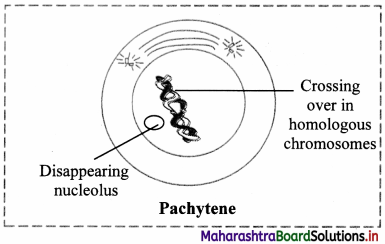
d. Diplotene:
The chiasma becomes clearly visible in diplotene due to beginning of repulsion between synapsed homologous chromosomes. This is known as desynapsis. Synaptonemal complex also starts to disappear.
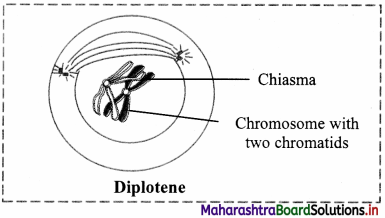
e. Diakinesis:
The chiasmata begin to move along the length of chromosomes from the centromere towards the ends of chromosomes. The displacement of chiasmata is termed as terminalization.
The terminal chiasmata exist till the metaphase.
The nucleolus and nuclear membrane completely disappear and spindle fibres begin to appear.
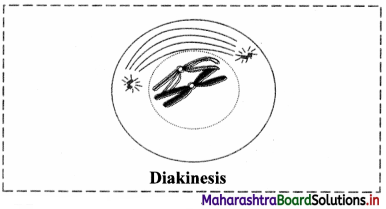
![]()
3. Draw labelled diagrams and write explanation
Question (A)
With the help of suitable diagram, describe the cell cycle.
Answer:
1. Series of events occurring in the life of a cell is called cell cycle. Interphase and M – phase are the two phases of cell cycle.
2. Interphase: It is the stage between two successive cell divisions. It is the longest phase of a cell cycle during which the cell is highly active and prepares itself for cell division.
The interphase is subdivided into three sub-phases as G1 – phase, S-phase and G2-phase.
a. G1 – phase (First gap period/First Gap Phase):
It begins immediately after cell division.
RNA (mRNA, rRNA and tRNA) synthesis, protein synthesis and synthesis of membranes take place during this phase.
b. S – phase (Synthesis phase):
In this phase DNA is synthesized (replicated), so that amount of DNA per cell doubles.
Synthesis of histone proteins takes place in this phase.
c. G2 – phase (Second growth phase/Second Gap Phase):
Metabolic activities essential for cell division occur during this phase.
Various proteins which are necessary for the cell division are also synthesized in this phase.
Apart from this, RNA synthesis also occurs during this phase.
In animal cells, a daughter pair of centrioles appears near the pre-existing pair.
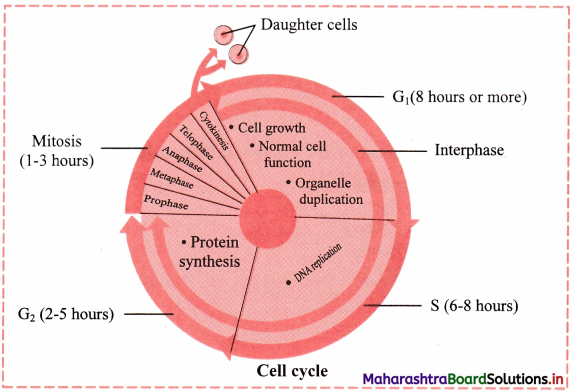
Question (B)
Distinguish between mitosis and meiosis.
Answer:
| Mitosis | Meiosis |
| (a) It occurs in somatic cells and stem cells. | It occurs in germ cells. |
| (b) In this nucleus divides only once. | In this nucleus divides twice (Meiosis I and Meiosis II) |
| (c) In these two daughter cells are formed. | In these four daughter cells are formed. |
| (d) Daughter cells formed by mitotic division are diploid (2n). | Daughter cells formed by meiotic division are haploid (n)• |
| (e) In mitosis, crossing over does not take place. | In meiosis, crossing over takes place. |
| (f) Mitosis plays an important role in growth, repair, healing and development. | Meiosis is important for formation of haploid gametes and spores. |
![]()
Question (C)
Draw labelled diagrams and write explanation Draw the diagram of metaphase.
Answer:
Metaphase:
a. Chromosomes are completely condensed and appear short.
b. Centromere and sister chromatids become very prominent.
c. All the chromosomes are arranged at equatorial plane of cell. This is called metaphase plate.
d. Mitotic spindle is fully formed in this phase.
e. Centromere of each chromosome divides horizontally into two, each being associated with a chromatid. [Note: The centromeres divide at the beginning of anaphase so that the two chromatids of each chromosome become separated from each other.
Source: Cell Division, Donald B. McMillan, Richard J. Harris, in An Atlas of Comparative Vertebrate Histology, 2018.]
Question 4.
Match the following column – A with column – B
| Column I (Phases) | Column II (Their events) |
| 1. Leptotene | (a) Crossing over |
| 2. Zygotene | (b) Desynapsis |
| 3. Pachytene | (c) Synapsis |
| 4. Diplotene | (d) Bouquet stage |
Answer:
| Column I (Phases) | Column II (Their events) |
| 1. Leptotene | (d) Bouquet stage |
| 2. Zygotene | (c) Synapsis |
| 3. Pachytene | (a) Crossing over |
| 4. Diplotene | (b) Desynapsis |
Question 5.
Is the given figure correct? Why?
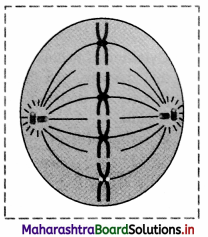
Answer:
1. The given figure is incorrect as the spindle fibres are not attached to centromere of the chromosomes.
2. During metaphase, chromosomes are attached to spindle fibres with the help of centromeres.
![]()
Question 6.
If an onion has 16 chromosomes in its leaf cell, how many chromosomes will be there in its root cell and pollen grain.
Answer:
1. The chromosomes in root cell will be 16 as root cell is a diploid cell.
2. The chromosomes in pollen grain will be 8 as pollen grain is a haploid cell.
7. Identify the following phases of mitosis and label the ‘A’ and ‘B’ given in diagrams.
Question (i)
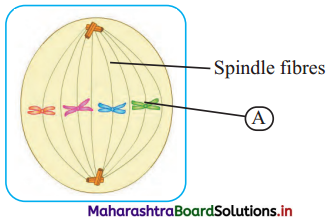
Answer:
The diagram shown is of Metaphase.
A: Chromosomes arranged on metaphase plate
Question (ii)

Answer:
The diagram shown is of Anaphase.
B: Chromatids moving to opposite poles.
![]()
Practical / Project:
Question 1.
Fix the onion root tips at different durations of the day starting from 6am up to 9am at the intervals of half an hour. Prepare the slide of each fixed root tip and analyse the relation between time and phase of mitosis.
Answer:
Mitotic division is an equational division in which one parent cell give rise to two daughter cells with equal number of chromosomes in daughter cells and mother cell. It has four sub phases: prophase, metaphase, anaphase, telophase.
Mitosis is affected by temperature and time. Mitotic index is high in morning so the mitosis is observed clearly in the morning. (Mitotic index is defined as the ratio between the number of cells in a population undergoing mitosis to the total number of cells in a population. )
[Note: Students catt use above information for reference and perform this activity on their own.]
11th Biology Digest Chapter 7 Cell Division Intext Questions and Answers
Can you recall? (Textbook Page No. 76)
How do your wounds heal?
Answer:
a. A wound is an injury to living tissue.
b. Healing of wound take place by mitosis.
c. Repetitive mitotic divisions near the site of injury results in healing of wound.
Can you tell? (Textbook Page No. 79)
What is cell cycle?
Answer:
- Sequential events occurring in the life of a cell is called cell cycle.
- Interphase and M – phase are the two phases of cell cycle.
- Cell undergoes growth or rest during interphase and divides during M – phase.
![]()
Discuss with teacher (Textbook Page No. 76)
Some cells do not have gap phase in their cell cycle whereas some cells spend maximum part of their life in gap phase. Search for such cells. Some cells are said to be in G0 phase. What is this G0 phase?
Answer:
- G0 is the phase of the cell cycle in eukaryotes in which many cell types stop dividing. It is also called a quiescent stage.
- If cells are deprived of appropriate growth factors, they stop at the Gi checkpoint of the cell cycle. Their growth and division are arrested and they remain in G0 phase.
- Mature neurons and muscle cells remain in G0 phase.
Question 5.
Can you tell? (Textbook Page No. 79)
Answer:
1. Series of events occurring in the life of a cell is called cell cycle. Interphase and M – phase are the two phases of cell cycle.
2. Interphase: It is the stage between two successive cell divisions. It is the longest phase of a cell cycle during which the cell is highly active and prepares itself for cell division.
The interphase is subdivided into three sub-phases as G1 – phase, S-phase and G2-phase.
a. G1 – phase (First gap period/First Gap Phase):
It begins immediately after cell division.
RNA (mRNA, rRNA and tRNA) synthesis, protein synthesis and synthesis of membranes take place during this phase.
b. S – phase (Synthesis phase):
In this phase DNA is synthesized (replicated), so that amount of DNA per cell doubles.
Synthesis of histone proteins takes place in this phase.
c. G2 – phase (Second growth phase/Second Gap Phase):
- Metabolic activities essential for cell division occur during this phase.
- Various proteins which are necessary for the cell division are also synthesized in this phase.
- Apart from this, RNA synthesis also occurs during this phase.
- In animal cells, a daughter pair of centrioles appears near the pre-existing pair.
![]()
Internet my friend (Textbook Page No. 77)
What is Karyogram or Karyotype?
Answer:
1. A karyotype is a representation of condensed chromosomes arranged in pairs.
2. Analysis of the karyotype of a particular individual indicates whether the individual has a normal set of chromosomes or whether there are abnormalities in number or appearance of individual chromosomes.
Can you tell? (Textbook Page No. 79)
Which are the steps of mitosis?
Answer:
Steps in mitosis are Karyokinesis and Cytokinesis. Karyokinesis includes four stages – Prophase, Metaphase, Anaphase and Telophase.
Internet my friend (Textbook Page No. 79)
How the life span of a cell is decided?
Answer:
- Life span of different cells vary greatly.
- Life span of a cell is decided by its growth rate, metabolic activities and cell size.
- The life span of a cell can be analysed in laboratory by applying carbon-14 technique to DNA.
- This method is commonly used in archaeology and paleontology to find the age of fossils. Same can be applied to determine the life span of a cell.
Do yourself (Textbook Page No. 80)
Write down the explanation of prophase I in your own words.
Answer:
1. Prophase -I:
It is the most complicated and longest phas0e of meiotic division.
It is further divided into five sub-phases viz. leptotene, zygotene, pachytene, diplotene and diakinesis.
a. Leptotene:
- The volume of the nucleus increases.
- The chromosomes become long distinct and coiled.
- They orient themselves in a specific fonn known as bouquet stage. This is characterized with the ends of chromosomes converged towards the side of nucleus where the centrosome lies.
- The centriole duplicates into two and migrates to opposite poles. [Note: Centrioles divide during Gj phase of interphase.]
b. Zygotene:
- Pairing of non-sister chromatids of homologous chromosomes takes place by formation of synaptonemal complex. This pairing is called synapsis.
- Each pair consists of a maternal chromosome and a paternal chromosome. Chromosomal pairs are called bivalents or tetrads.
c. Pachytene:
- Each individual chromosome begins to split longitudinally into two similar chromatids. Therefore, each bivalent now appears as a tetrad consisting of four chromatids.
- The homologous chromosomes begin to separate but they do not separate completely and remain attached to one or more points.
- These points are called chiasmata (Appear like a cross-X).
- Chromatids break at these points and broken segments are exchanged between non-sister chromatids of homologous chromosomes resulting in recombination.
d. Diplotene:
The chiasma becomes clearly visible in diplotene due to beginning of repulsion between synapsed homologous chromosomes. This is known as desynapsis. Synaptonemal complex also starts to disappear.
e. Diakinesis:
- The chiasmata begin to move along the length of chromosomes from the centromere towards the ends of chromosomes. The displacement of chiasmata is termed as terminalization.
- The terminal chiasmata exist till the metaphase.
- The nucleolus and nuclear membrane completely disappear and spindle fibres begin to appear.
![]()
Curiosity Box: (Textbook Page No. 81)
(i) What is exact structure of synaptonemal complex?
Answer:
Synaptonemal complexes are zipper like structures assembled between homologous chromosomes during the prophase of first meiotic division.
[Source: ncbi.nlm. nih.gov/pubmed/8743892]
(ii) What is structure of chiasma?
Answer:
Chiasma is a X-shaped point of attachment between two non-sister chromatids of a homologous chromosomes.
(iii) Which type of proteins are involved in formation of spindle fibres?
Answer:
Spindle fibres are formed from microtubules with many accessory proteins.
(iv) Why and how spindle fibres elongate and some contract?
Answer:
a. Spindle fibres elongate for assembly of chromosomes at equatorial plane of the cell during metaphase and spindle fibres contract for pulling chromosomes towards opposite poles during anaphase.
b. The spindle fibres elongate (polymerize) by incorporating subunits of the protein tubulin and contract
(v) What is the role of centrioles in formation of spindle apparatus?
Answer:
Centriole plays an important role in cell division. Centrioles help organize microtubule assembly and forms spindle apparatus that separate the chromosomes during cell division.
Curiosity box (Textbook Page No. 81)
What would have happened in absence of meiosis?
Answer:
- Gametes are produced by the process of meiosis which are essential for sexual reproduction.
- Diploid organisms have two set of chromosomes (one paternal and one maternal).
- For a diploid organism to undergo sexual reproduction it needs to create gametes that contain only one set of chromosomes so the number of chromosomes remains same in the next generation.
- In absence of meiosis, the chromosome number of parents and their offsprings will differ in every generation; hence no species will hold its characters.
- Also, there will be no crossing over of homologous chromosomes. Thus, there will be no variations with respect to the changing environment in progeny to maintain their existence, which may lead to extinction of species.
![]()
Can you tell? (Textbook Page No. 82)
(i) What is the difference between mitosis and meiosis?
Answer:
| Mitosis | Meiosis |
| (a) It occurs in somatic cells and stem cells. | It occurs in germ cells. |
| (b) In this nucleus divides only once. | In this nucleus divides twice (Meiosis I and Meiosis II) |
| (c) In these two daughter cells are formed. | In these four daughter cells are formed. |
| (d) Daughter cells formed by mitotic division are diploid (2n). | Daughter cells formed by meiotic division are haploid (n) • |
| (e) In mitosis, crossing over does not take place. | In meiosis, crossing over takes place. |
| (f) Mitosis plays an important role in growth, repair, healing and development. | Meiosis is important for formation of haploid gametes and spores. |
(ii) What is difference between meiosis – I and meiosis – II?
Answer:
| Meiosis I | Meiosis II |
| (a) Diploid cell is divided into two haploid cells. | Two haploid cells formed in meiosis I divides further into four haploid cells. |
| (b) This division is called heterotypic division. | This division is called homotypic (equational) division. |
| (c) It consists of prophase – I, metaphase – I, anaphase -1, telophase -1 and cytokinesis. | It consists of prophase – II, metaphase – II, anaphase – II, telophase – II and cytokinesis. |
| (d) Number of chromosomes is reduced to half, i.e. from diploid to haploid state. | In meiosis II number of chromosomes remain the same. |
| (e) It is complicated and long duration division. | It is simple and short duration division. |
| (f) Telophase I results into 2 daughter cells. | Telophase II results in 4 daughter cells. |
![]()
(iii) Elaborate the process of recombination.
Answer:
a. Recombination is exchange of genetic material between paternal and maternal chromosomes during gamete formation.
b. The points where crossing over takes place is known as chiasmata.
c. Chromatids acquire new combinations of alleles by physically exchanging segments in crossing-over.
d. The exchange of genetic material between homologous chromosomes involves accurate breakage and joining of DNA molecules through a complex mechanism.
e. It is catalyzed by enzymes.
Do Yourself (Textbook Page No. 82)
Prepare a concept map on cell division in following box.
Answer:
Refer Quick Review
![]()
Internet My Friend (Textbook Page No. 82)
Different types of proteins like cyclins, maturation promoting factor (MPF), cyclosomes, enzymes like cyclin dependent kinases (CDK) play important role in control of cell cycle. Collect more information about these proteins and enzymes from internet, prepare a power-point presentation and present it in the class.
Answer:
- The regulation of the cell cycle involves an internal control system consisting of proteins called cyclins and enzymes called cyclin-dependent kinases.
- A Cdk is a protein kinase. When the kinase of the Cdk is activated upon binding to a cyclin, it phosphorylates target proteins in the cell, regulating their activities.
- Those proteins play important roles in initiating or regulating significant events of the cell cycle, such as DNA replication, mitosis, and cytokinesis.
- Maturation Promoting Factor (MPF) triggers the cell’s passage into the mitotic phase.
[Note: Students are expected to perform the above activity by their own with the help of information provided in the answer.]
Maharashtra State Board Class 11 Biology Textbook Solutions
- Living World Class 11 Biology Textbook Solutions
- Systematics of Living Organisms Class 11 Biology Textbook Solutions
- Kingdom Plantae Class 11 Biology Textbook Solutions
- Kingdom Animalia Class 11 Biology Textbook Solutions
- Cell Structure and Organization Class 11 Biology Textbook Solutions
- Biomolecules Class 11 Biology Textbook Solutions
- Cell Division Class 11 Biology Textbook Solutions
